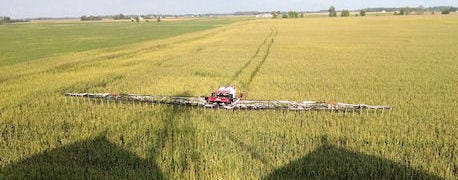
You may have seen Mike Shuter's rig on the cover of Corn and Soybean Digest recently. He works with another local farmer, and he was identified, but Shuter wasn't. But it's Shuter, Frankton, who has put together the machine and is starting to market it to other people who want to get a head start on seeding cover crops in the fall.
Related: Cover Crop Termination Rules Updated By USDA

High-clearance seeder: Patrick Shuter, Frankton, took this picture of his dad, Mike, seeding cover corps into standing corn with the rig that he and his dad put together earlier this year.
"We started a few weeks ago seeding cover crops into corn," he says. "We will also seed cover crops into standing soybeans. The whole idea is to get a start on the growing season. Many cover crops need to be seeded before crops come off in the fall so they can get established and get enough growth going into winter."
Shuter moved to cover crops to augment his no-till operation and improve soil health. He's seeing many other farmers wanting to go the same way. Having an easy, effective way to get cover crops seeded in time in the fall is a bottleneck he's addressing with his new start-up business.
Annual ryegrass needs to be seeded by mid-September to get a good start, many people say. Then success depends upon getting some timely rains to get it germinated and established. Cereal rye is one cover crop that can be seeded late, even up until early November. Some prefer to drill it after harvest, but it can also be applied aerially or through a high-clearance rig to get it out earlier.
Related: Where You Live May Affect Cover Crop Choice
This season's later-maturing crops may make seeding cover crops early an even bigger advantage. By the time some soybeans and corn are ready to harvest, cereal rye might be one of the only legitimate options left for cover crops. Cereal rye reportedly does well ahead of soybeans. However, some specialists say it's tougher to handle in the spring ahead of no-till corn.
Thinking about a cover crop? Start with developing a plan. Download the FREE Cover Crops: Best Management Practices report today, and get the information you need to tailor a cover crop program to your needs.
About the Author(s)
You May Also Like




